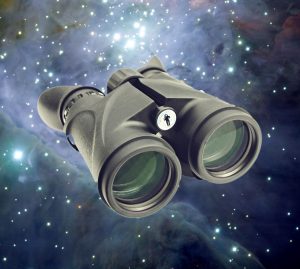3D Astronomy Space Walker Binocular Review: I’m at a loss for words. Oh, it’s easy enough to conclude that I tried 3D Astronomy’s 8×42 Space Walker binoculars and enjoyed them – so much so that I re: commend you try them, too. The hard part is conveying why.
You expect to read rational analyses of products in ATT, but I have none to offer for the Space Walkers. The experience is too subjective. Do you need binoculars that produce a dramatic 3D effect? No. Neither do I. Standard binoculars deliver views of the night sky that are spectacular enough without added 3D augmentation, right? Nope!
The 3D Astronomy Space Walker Binocular binoculars are the brainstorm of Russ Lederman, who knows a thing or two about viewing the heavens in stereo. After all, he founded Denkmeier Optical, maker of some of the planet’s most coveted binoviewers.
Before Space Walkers
Before I tried the 3D Astronomy Space Walker Binocular, my favorite night-sky binos were vintage 7x50s. 7x, because I prefer observing with binos handheld, and my hands are too unsteady for magnifications of 10x, or greater. 50 mm, because that’s what I’d long judged the minimum threshold for meaningful brightening of classic binocular targets.
But those beloved 7x50s are no longer my favorites. Which is not to say that the Space Walker 8x42s have replaced them. No, it’s just that I now want both.

Physical Attributes
Before I address their 3D aspect, I should note that the Space Walkers are mechanically excellent. The sample I tested were well collimated out of the box and held collimation. Focus action was smooth and sure, and adjustment of the interpupillary distance was equally satisfying. The kit included a soft-sided carry case, captive lens and eyepiece caps, a neck strap and winged eye guards.
Better yet, its 8x magnification factor was still low enough to enjoy despite my shaky hands. The Space Walkers are significantly lighter than my 7x50s, too, making them inherently easier to hold steadily. And although their 42-mm twin apertures are significantly smaller than those of my cherished 7x50s, the Space Walker binoculars’ modern antireflection coatings are so much better than the vintage treatments of the larger binos, objects appear a tad brighter and sharper, despite their smaller apertures.
Stereo Versus Monocular Views
Compared with right-or left-eye observations through the single eyepiece of a telescope, viewing with both eyes delivers an inherent perception of depth, and of course, Russ knows this as well as anyone. It’s a key factor in the popularity of Denkmeier binoviewers.
And I use “depth,” as opposed to “3D effect,” advisedly in this context. Here’s why. As I look up from my laptop display, I observe my immediate space and its contents in three full dimensions. This is due in part to the proximity of the objects in this room, which makes it easy for my mind to detect right eye-vs-left eye parallax.

But when I cover either eye with my hand, my mind still perceives this room as three dimensional, if only by interpreting the interplay between shadow and perspective. Just as a one-eyed fellow still knows the baseball is flying towards him, if only because it appears to be getting bigger, my mind deduces the orientation of my bicycle because the front wheel appears so much larger than its rear.
When I view celestial objects located at infinity (and thus beyond my mind’s eye ability to detect parallax) through the single eyepiece of a telescope, I have no such spatial clues. Ditto, when I view the night sky with both unaided eyes. But, add a binoviewer to the telescope, and while I still detect no real spatial clues and no actual parallax, my mind nevertheless reports a sensation of depth. I reason that this is because my mind’s eye is so thoroughly used to observations made with my right eye alone peering through the single eyepiece of a telescope, it concludes that viewing in stereo through a telescope must yield a greater sensation, i.e., depth!
But no, this is not depth as in the distinct sensation of three full dimensions, but it is a pleasing sensation of depth, nonetheless. I’ll call it “proto-depth,” and, for me, proto-depth is enough to transform “wow” into “WOW.” And, as I asked earlier, WOW is more than enough for any observer, right?
I certainly thought so … until I used the Space Walker binoculars.
How the 3D Astronomy Space Walker Binocular Work
The Space Walkers perform a neat trick, fooling our minds into “seeing” three full dimensions, as opposed to mere proto-depth. WOW becomes “WOW+++!!!”
Remember those Magic Eye random-dot stereogram posters that were so popular decades ago? No? Well, I’m sorry you missed them. Here’s a link that explains the phenomena.
Random-dot stereograms work, because our perceptions of depth happen in our brains, not in our eyes. But some observers of Magic Eye posters perceive the 3D effect easily, others require a bit of practice, and some never do. Not so the Space Walkers. When the targets are night-sky celestial scenes, the Space Walkers just work. If you are comfortable using standard binoculars, Space Walkers will trick you into the seamless perception of three full dimensions. Guaranteed.
The trickery is installed in the left-hand optical tube of the Space Walker binoculars and, although I haven’t asked Russ to confirm it, I suspect that too is by calculated design. View a bright, uniform background with both eyes through the Space Walkers, and you will see three translucent squares – as if through both eyes. Try as I might, I could not get my cell-phone camera to focus on those rectangles. Anyway, close your left eye, and the three squares of optical glass disappear, because, yeah, they are only in the left-hand optical tube.
The three squares are arranged in a stair-step pattern, descending from left to right. This is a version of Russ’ patent-pending “L-O-A 3D” system, which stands, appropriately enough, for “Lederman optical array.”
How does the three-square array work? I’ve no idea. I can only report from independent observation that it does indeed work. When I observe star fields trough the Space Walker binoculars, my mind’s eye perceives not a similar stair-step pattern of 3D-ness, but a seamlessly immersive field-wide expanse of total 3D goodness! And I very much enjoy that sensation.
But Terrestrial Views?
Before adding any weighty gadget to my bike’s payload, I first ask, “Can it serve more than one function?” Standard binoculars survive this test, because I use them to enhance both terrestrial and celestial views. But, can the Space Walkers? Turns out, yes, they can … with a bit of practice.
Year ago, before right-angle, correct-image optical finder scopes were so readily available, we used straight-through optical finders. Although right-angle finders are generally easier on my aging neck and back, I still prefer straight-through finders.
As I view through a straight-through finder scope with my right eye, my left eye remains open, allowing me to simultaneously perceive a magnified image and a unity (1x) image simultaneously … after a bit of practice. Do this long enough, and your mind’s eye can switch, back and forth, from the magnified view to the unity view, without winking either eye. Very hand, that. You can’t do it through a right-angle finder.
Well, after a bit of practice, I could do something similar when using the 3D Astronomy Space Walker Binocular for viewing daylight terrestrial scenes, switching my mind’s eye from 3D mode to standard mode – back and forth – without physical effort.
Would I buy them for terrestrial views alone? No, of course not. Why invest in terrestrial binoculars you’re going to have to train your mind to use? But, if you invest in Space Walkers for their unique full-3D performance, it’s nice to know they can serve you competently in daylight, too.
Conclusion
I’ve written a lot here, but said little of real substance. Bottom line, I still feel at a loss for words to describe the unique Space Walker binocular 3D sensation.
Do I really need them? Nope, no more than I need a quality telescope on a competent tracking mount. Boil astro tech down to only what is essential, and I suppose none of us really need anything but healthy eyes, clear dark skies and uncluttered horizons to enjoy life-enhancing observations of the heavens. But, I’m awfully glad we have so many view-enhancing options. Standard binoculars allow us to see much more than we can with unaided eyes. Space Walker binoculars allow us to see and perceive much more – a full third dimension more.
Still, this may very well be the most subjective astro-tech experience I’ve encountered. Is the 3D Astronomy Space Walker Binocular worth the $315US price of admission? For me, the answer is easy: Yes. For you? For you, I’m back where I started, at a loss to describe the totally subjective, completely immersive three-dimensional perception. All I can say with absolute confidence is that you should try them for yourself, and if you’re lucky, you’ll experience what I did.
 By Gary Parkerson
By Gary Parkerson
Astronomy Technology Today Executive Editor Gary Parkerson discovered early in his amateur-astronomy career that he was as fascinated by the tools of astronomy as by the amazing celestial objects they reveal – perhaps more so. When not writing about astro-tech, he covers industrial technology for a variety of online resources.
And to make it easier for you to get the most extensive telescope and amateur astronomy related news, articles and reviews that are only available in the magazine pages of Astronomy Technology Today, we are offering a 1 year subscription for only $6! Or, for an even better deal, we are offering 2 years for only $9. Click here to get these deals which only will be available for a very limited time. You can also check out a free sample issue here.

